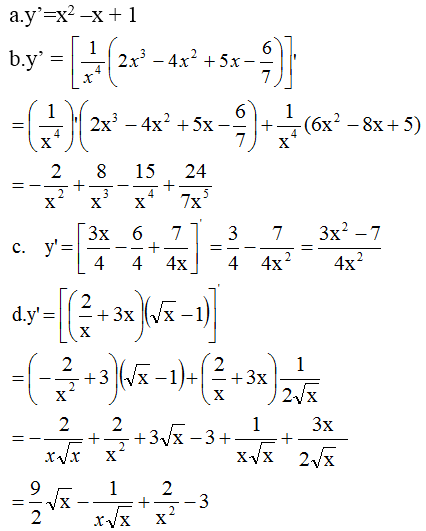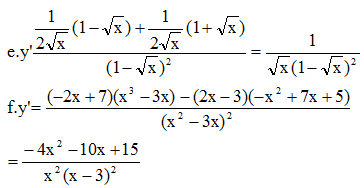Hãy nhập câu hỏi của bạn vào đây, nếu là tài khoản VIP, bạn sẽ được ưu tiên trả lời.

Chứng minh các biểu thức đã cho không phụ thuộc vào x.
Từ đó suy ra f'(x)=0
a) f(x)=1⇒f′(x)=0f(x)=1⇒f′(x)=0 ;
b) f(x)=1⇒f′(x)=0f(x)=1⇒f′(x)=0 ;
c) f(x)=\(\frac{1}{4}\)(\(\sqrt{2}\)-\(\sqrt{6}\))=>f'(x)=0
d,f(x)=\(\frac{3}{2}\)=>f'(x)=0

ta có (f(x)-20)/(x-2)=10
===>f(x)=10x
thay f(x)=10x vào A và thay
x=2+0,000000001 ta được giới hạn của A= -331259694,9
cái chỗ F(x) =10x đó ,đâu có là sao vậy ạ , tại có thể 10 đó là g(2)=10

a: \(6^x=5\)
=>\(x=log_65\)
b: \(7^{3-x}=5\)
=>\(3-x=log_75\)
=>\(x=3-log_75\)
c: \(\left(\dfrac{3}{5}\right)^{x-2}=\dfrac{27}{125}\)
=>\(\left(\dfrac{3}{5}\right)^{x-2}=\left(\dfrac{3}{5}\right)^3\)
=>x-2=3
=>x=5
d: \(\left(\dfrac{4}{5}\right)^x=\dfrac{5}{4}\)
=>\(\left(\dfrac{4}{5}\right)^x=\left(\dfrac{4}{5}\right)^{-1}\)
=>x=-1
a.
\(6^x=5\Rightarrow x=log_65\)
b.
\(7^{3-x}=5\Rightarrow3-x=log_75\)
\(\Rightarrow x=3-log_75\)
c.
\(\left(\dfrac{3}{5}\right)^{x-2}=\dfrac{27}{125}\Rightarrow x-2=log_{\dfrac{3}{5}}\left(\dfrac{27}{125}\right)\)
\(\Rightarrow x-2=3\Rightarrow x=5\)
d.
\(\left(\dfrac{4}{5}\right)^x=\dfrac{5}{4}\Rightarrow\left(\dfrac{4}{5}\right)^x=\left(\dfrac{4}{5}\right)^{-1}\)
\(\Rightarrow x=-1\)

a) Để tính sin2x, cos2x, tan2x và cot2x, chúng ta cần biết giá trị của cosx trước đã. Theo như bạn đã cho, cosx = -1/4. Vậy sinx sẽ bằng căn bậc hai của 1 - cos^2(x) = căn bậc hai của 1 - (-1/4)^2 = căn bậc hai của 1 - 1/16 = căn bậc hai của 15/16 = sqrt(15)/4. Sau đó, chúng ta có thể tính các giá trị khác như sau: sin2x = (2sinx*cosx) = 2 * (sqrt(15)/4) * (-1/4) = -sqrt(15)/8 cos2x = (2cos^2(x) - 1) = 2 * (-1/4)^2 - 1 = 2/16 - 1 = -14/16 = -7/8 tan2x = sin2x/cos2x = (-sqrt(15)/8) / (-7/8) = sqrt(15) / 7 cot2x = 1/tan2x = 7/sqrt(15) b) Để tính sin(x + 5π/6), chúng ta có thể sử dụng công thức sin(a + b) = sin(a)cos(b) + cos(a)sin(b). Với a = x và b = 5π/6, ta có: sin(x + 5π/6) = sin(x)cos(5π/6) + cos(x)sin(5π/6) = sin(x)(-sqrt(3)/2) + cos(x)(1/2) = (-sqrt(3)/2)sin(x) + (1/2)cos(x) c) Để tính cos(π/6 - x), chúng ta sử dụng công thức cos(a - b) = cos(a)cos(b) + sin(a)sin(b). Với a = π/6 và b = x, ta có: cos(π/6 - x) = cos(π/6)cos(x) + sin(π/6)sin(x) = (√3/2)cos(x) + 1/2sin(x) d) Để tính tan(x + π/3), chúng ta có thể sử dụng công thức tan(a + b) = (tan(a) + tan(b))/(1 - tan(a)tan(b)). Với a = x và b = π/3, ta có: tan(x + π/3) = (tan(x) + tan(π/3))/(1 - tan(x)tan(π/3))
a: pi/2<x<pi
=>sin x>0
=>\(sinx=\sqrt{1-\left(-\dfrac{1}{4}\right)^2}=\dfrac{\sqrt{15}}{4}\)
\(sin2x=2\cdot sinx\cdot cosx=2\cdot\dfrac{\sqrt{15}}{4}\cdot\dfrac{-1}{4}=\dfrac{-\sqrt{15}}{8}\)
\(cos2x=2\cdot cos^2x-1=2\cdot\dfrac{1}{16}-1=-\dfrac{7}{8}\)
\(tan2x=-\dfrac{\sqrt{15}}{8}:\dfrac{-7}{8}=\dfrac{\sqrt{15}}{7}\)
\(cot2x=1:\dfrac{\sqrt{15}}{7}=\dfrac{7}{\sqrt{15}}\)
b: sin(x+5/6pi)
=sinx*cos(5/6pi)+cosx*sin(5/6pi)
\(=\dfrac{\sqrt{15}}{4}\cdot\dfrac{-\sqrt{3}}{2}+\dfrac{1}{2}\cdot\dfrac{-1}{4}=\dfrac{-\sqrt{45}-1}{8}\)
c: cos(pi/6-x)
=cos(pi/6)*cosx+sin(pi/6)*sinx
\(=\dfrac{\sqrt{3}}{2}\cdot\dfrac{-1}{4}+\dfrac{1}{2}\cdot\dfrac{\sqrt{15}}{4}=\dfrac{-\sqrt{3}+\sqrt{15}}{8}\)
d: tan(x+pi/3)
\(=\dfrac{tanx+tan\left(\dfrac{pi}{3}\right)}{1-tanx\cdot tan\left(\dfrac{pi}{3}\right)}\)
\(=\dfrac{-\sqrt{15}+\sqrt{3}}{1+\sqrt{15}\cdot\sqrt{3}}=\dfrac{-\sqrt{15}+\sqrt{3}}{1+3\sqrt{5}}\)

\(\lim\limits_{x\rightarrow1}\dfrac{x^3-3x+2}{x^4-4x+3}=\lim\limits_{x\rightarrow1}\dfrac{\left(x+2\right)\left(x-1\right)^2}{\left(x^2+2x+3\right)\left(x-1\right)^2}=\lim\limits_{x\rightarrow1}\dfrac{x+2}{x^2+2x+3}=\dfrac{1}{2}\)
\(\lim\limits_{x\rightarrow2^-}\dfrac{x^3+x^2-4x-4}{x^2-4x+4}=\lim\limits_{x\rightarrow2^-}\dfrac{\left(x-2\right)\left(x^2+3x+2\right)}{\left(x-2\right)^2}=\lim\limits_{x\rightarrow2^-}\dfrac{x^2+3x+2}{x-2}=-\infty\)
\(\lim\limits_{x\rightarrow2}\dfrac{\left(x^2-x-2\right)^{20}}{\left(x^3-12x+16\right)^{10}}=\lim\limits_{x\rightarrow2}\dfrac{\left(x+1\right)^{20}\left(x-2\right)^{20}}{\left(x+4\right)^{10}\left(x-2\right)^{20}}=\lim\limits_{x\rightarrow2}\dfrac{\left(x+1\right)^{20}}{\left(x+4\right)^{10}}=\dfrac{3^{10}}{2^{10}}\)
\(\lim\limits_{x\rightarrow0^-}\dfrac{4x^2+5x}{x^2}=\lim\limits_{x\rightarrow0^-}\dfrac{4x+5}{x}=-\infty\)
\(\lim\limits_{x\rightarrow-1}\dfrac{\sqrt{x+2}-1}{\sqrt{x+5}-2}=\lim\limits_{x\rightarrow-1}\dfrac{\left(x+1\right)\left(\sqrt{x+5}+2\right)}{\left(x+1\right)\left(\sqrt{x+2}+1\right)}=\lim\limits_{x\rightarrow-1}\dfrac{\sqrt{x+5}+2}{\sqrt{x+2}+1}=2\)



